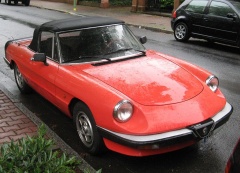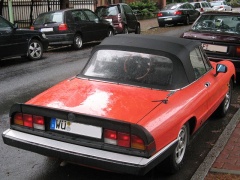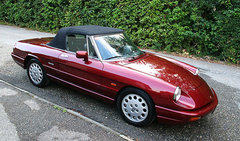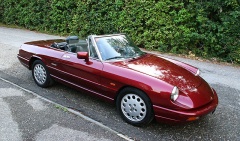Difference between revisions of "Alfa Romeo Spider Veloce"
m |
m |
||
| Line 150: | Line 150: | ||
|} | |} | ||
| − | {| border=1 cellspacing=3 cellpadding=4 style="float: | + | {| border=1 cellspacing=3 cellpadding=4 style="float:right; margin:0 0 .5em 1em; width:400px; background:#505050; border-collapse:collapse; border:1px solid #999; font-size:83%; line-height:1.5; " summary="Infobox Automobile" |
|- style="text-align:center; background:#505050;" | |- style="text-align:center; background:#505050;" | ||
|- tr BGCOLOR=darkred | |- tr BGCOLOR=darkred | ||
Revision as of 16:55, 22 October 2009


| |
| Alfa Romeo Spider | |
|---|---|
| Manufacturer: | Alfa Romeo |
| Production: | 1966–1993 |
| Body Styles: | FR 2-seater roadster |
| Predecessors: | Alfa Romeo Giuletta Spider |
| Successors: | Alfa Romeo Spider (1995) |
| Competitors: | Lotus Elan |
| Related: | Alfa Romeo Giulia |
| Designer: | Pininfarina |
The Alfa Romeo Spider is a roadster produced by the Italian manufacturer Alfa Romeo from 1966 to 1993 (190 Spiders were badged as 1994 Commemorative Editions for the North American market). Widely regarded as a design classic, it remained in production for almost three decades with only minor aesthetic and mechanical changes. The three first series were assembled by Pininfarina in Grugliasco and the fourth series in San Giorgio Canavese.
History
Series 1 Spider (1966-1969)
Based on the Giulia 105 series chassis, the Spider was launched in 36th Geneva Motor Show in 1966. Unnamed at launch, the name "Duetto" was chosen in a write-in competition in Italy. The Italian firm of Pininfarina was responsible for the design of the body; in fact, the Duetto was the last project with which founder Battista "Pinin" Farina was personally associated. Pininfarina were also responsible for the manufacture of the vehicle's monocoque construction (designed with the relatively new principles of crumple zones incorporated into the front and rear). The engine was a 1570cc variant of the Alfa Romeo twin cam four cylinder engine, and produced 109hp. Sparsely fitted inside but including five speed transmission, disc brakes and independent front suspension, the price on launch in Italy was 2,195,000 lire.
The original "Duetto" was in production from 1966-1967; replaced in late 1967 by the 1750 Spider Veloce, powered by a 118hp 1779cc engine. In Europe this was fitted with two twin carburettors, whereas models for the North American market (from MY 1969) had SPICA (Società Pompe Iniezione Cassani & Affini) mechanical fuel injection.
Modifications were also made to the suspension, brakes, electrics and wheels and tyres though the car looked effectively the same. Visible differences were limited to the rear-view mirror repositioned to the door, and different badging on the tail. During the production run, the front repeater lights were moved ahead of the wheelarches. The car's official title was 1750 Spider Veloce, the name "Duetto" being dropped from this point on.
A new Spider 1300 Junior, with a 1290cc engine producing 89hp, was introduced in 1968. This lacked various features of the 1750, including the plastic headlight fairings, the brake servo, hubcaps and opening quarterlight.
Due to its round (or long) tail, the Series 1 Spider is sometimes known by the nick-name of "Osso di Sepia" - Italian for cuttlebone fish.
Series 2 Spider (1970-1982/83)
In 1970 the first significant change to the exterior styling was introduced on the 1750 Spider Veloce, with the original's distinctive elongated round tail changed to a more conventional cut-off tail, called the "Kamm tail", as well as improving the luggage space. Numerous other small changes took place both inside and out, such as a slightly different grille, new doorhandles, a more raked windscreen, top-hinged pedals and improved interior trim.
1971 saw the Spider Veloce get a new, larger powerplant - a 1962cc, 132hp unit - and consequently the name was changed from 1750 Spider Veloce to 2000 Spider Veloce. The 1600 Spider restarted production a year later as the Spider 1600 Junior, and was visually identical to the 1300.
The 1300 and 2000 cars were modified in 1974 and 1975 respectively to include two small seats behind the front seats, becoming a "two plus two" four seater. The 1300 model was discontinued in 1977. Also, between 1974 and 1976, the early-style stainless-steel bumpers were discontinued and replaced with black, rubber-clad units to meet increasingly stringent North American crash requirements.
Series 3 Spider (1982/83-1989/90)
The Series 3 Spider was previewed in North America for the 1982 model year with the introduction of 2.0 liter Bosch electronic fuel injection to replace the SPICA mechanical injection.
The Spider underwent a major styling revamp in 1983, which saw the introduction of black rubber front and rear bumpers. The front bumper incorporated the grille and a small soft rubber spoiler was added to the trunk lid. The change altered the exterior appearance of the car considerably and was not universally praised by enthusiasts. Various other minor mechanical and aesthetic modifications were also made, and the 1600 car (never available in North America) dropped the "Junior" name.
The Quadrifoglio Verde (Green Fourleaf Clover) model was introduced in 1986, with many aesthetic tweaks, including sideskirts, mirrors, new front and rear spoilers, hard rubber trunk mounted spolirs with integral 3rd stoplight and optional removable hardtop. It was otherwise mechanically identical to the standard Spider Veloce model, with a 1962cc double overhead cam, four-cylinder engine (twin two-barrel carburetors in Europe; North American models retained the Bosch L-Jetronic fuel injection introduced for the 1982 model year except that the VVT mechanism was now L-Jet activated) and five-speed manual transmission.
The interiors was revised with a new center console, lower dash panels (to meet U.S. regulations) and a single monopod gauge cluster (with electronic gauges). For the North American market a model dubbed the Graduate was added in tribute to the car's famous appearance in the 1967 film, The Graduate, starring Dustin Hoffman.
The Graduate was intended as a less expensive "entry-level" Alfa. While it had the same engine and transmission as the Quadrifoglio and Spider, it lacked the alloy wheels and luxury features of the other two models. The Graduate model had manual windows, basic vinyl seats, a vinyl top, and steel wheels as standard. Air conditioning and a dealer-installed radio were the only options. It first appeared in 1985 in North America and continued until 1990.
Minor changes occurred from 1986-89, including new paint colors, a center high mount stop lamp (CHMSL) midway through 1986 for North American models, a move away from the fade-prone brown carpet and new turn signal levers. Some 1988 models featured automatic [seatbelts] that extended from a large device between the front seats.
Series 4 Spider (1990/91-1994)
The final major change to the Spider came in 1990. The primary mechanical change was that the Spider was given Bosch Motronic electronic fuel injection with an electric fan. Externally, the Spider lost its front under-bumper spoiler and the rear trunk-lid spoiler and picked up 164-style rear lights stretching across the width of the car as well as plastic bumpers the same color as the car.
In North America, the styling changes didn't appear until the 1991 model year; 1990 models featured the Motronic fuel injection but retained the black bumpers. Power steering, larger knee bolsters and a driver-side airbag also appeared as standard for North American market Spiders, which were available in two configurations: Spider and Spider Veloce. Primary differences were in standard equipment; the Veloce substituted leather seats for the base model's vinyl, 15" alloy wheels were one size up from the standard steel wheels with hubcaps, air conditioning and a cloth top were standard.
Production of the original Spider ended in 1993. An all-new Alfa Spider arrived one year later.
A limited edition Spider Commemorative Edition was produced for the North American market in 1993 and was badged as a 1994 model. Each of the 190 Spider CEs imported to the United States had a small plaque affixed to the dashboard that identified which of the 190 cars it was. The CEs differed from previous Spiders in that they had a special badge on the nose, a "CE" script badge below the "Spider Veloce" badge on the tail, unique gold center caps on the "phonedial" 15" wheels, and burled wood interior trim. Each model came with a leather portfolio, numbered keychain, and documentation. The cars followed the VIN sequence 008276 to 008460, although there does not appear to be any systematic order numbering. It appears that all of the 1994 Spider Commemorative Editions were produced in May 1993.
Production 1970 - 1993
| Year | Units made |
| 1970 | 2,539 |
| 1971 | 3,735 |
| 1972 | 4,121 |
| 1973 | 4,848 |
| 1974 | 5,107 |
| 1975 | 5,189 |
| 1976 | 4,338 |
| 1977 | 4,183 |
| 1978 | 3,868 |
| 1979 | 4,129 |
| 1980 | 5,584 |
| 1981 | 1,653 |
| 1982 | 1,923 |
| 1983 | 5,365 |
| 1984 | 6,587 |
| 1985 | 5,590 |
| 1986 | 7,215 |
| 1987 | 4,339 |
| 1988 | 4,090 |
| 1989 | 3,950 |
| 1990 | 7,106 |
| 1991 | 9,073 |
| 1992 | 3,640 |
| 1993 | 1,956 |
| Generations of Models | Engine | Power | Torque | Years |
| Serie 1: Duetto or osso di sepia | ||||
| Duetto | 1600 cc | 109Hp | 142Nm | 1966-1967 |
| 1750 Veloce | 1779 cc | 118Hp | 186Nm | 1967-1969 |
| 1750 Veloce US version | 1779 cc | 132Hp | 186Nm | 1969 |
| 1300 Junior | 1290 cc | 89Hp | - | 1968-1969 |
| Serie 2: Fastback or Coda Tronca | ||||
| 1750 Veloce | 1779 cc | 133Hp | 187Nm | 1970-1973 |
| 1300 Junior | 1290 cc | 104Hp | 137Nm | 1970-1973 |
| 2000 Veloce | 1962 cc | 128Hp | - | 1971-1982 |
| 1600 Junior | 1570 cc | 110Hp | - | 1972-1981 |
| Serie 3: Aerodinamica | ||||
| Aerodinamica 2000 | 1962 cc | 128Hp | 178Nm | 1982-1989 |
| Aerodinamica 1600 | 1570 cc | 104Hp | 142Nm | 1983-1989 |
| 2000 Quadrifoglio Verde | 1962 cc | 132Hp | - | 1985-1989 |
| Serie 4 | ||||
| Type 4 | 1962 cc | 126Hp | 166Nm | 1990-1993 |
Gallery
1966 Alfa Romeo Spider Duetto
- 1966 Alfa Romeo Spider Duetto 1.jpg
- 1966 Alfa Romeo Spider Duetto 2.jpg
- 1966 Alfa Romeo Spider Duetto 3.jpg
- 1966 Alfa Romeo Spider Duetto 4.jpg
- 1966 Alfa Romeo Spider Duetto 5.jpg
- 1966 Alfa Romeo Spider Duetto 6.jpg
- 1966 Alfa Romeo Spider Duetto 7.jpg
- 1966 Alfa Romeo Spider Duetto 8.jpg
- 1966 Alfa Romeo Spider Duetto 9.jpg
- 1966 Alfa Romeo Spider Duetto 10.jpg
- 1966 Alfa Romeo Spider Duetto 11.jpg
- 1966 Alfa Romeo Spider Duetto 12.jpg
- 1966 Alfa Romeo Spider Duetto 13.jpg
- 1966 Alfa Romeo Spider Duetto 14.jpg
- 1966 Alfa Romeo Spider Duetto 15.jpg
- 1966 Alfa Romeo Spider Duetto .jpg
External Links
| <- Previous | Alfa Romeo Automobiles S.p.A., a subsidiary of the Fiat S.p.A. since 1986, car timeline, 1946-1979 | Next -> | ||||||||||||||||||||||||||||||||||||||||||
| Type | 1950s | 1960s | 1970s | |||||||||||||||||||||||||||||||||||||||||
| 0 | 1 | 2 | 3 | 4 | 5 | 6 | 7 | 8 | 9 | 0 | 1 | 2 | 3 | 4 | 5 | 6 | 7 | 8 | 9 | 0 | 1 | 2 | 3 | 4 | 5 | 6 | 7 | 8 | 9 | |||||||||||||||
| Small family car | Dauphine* | Alfasud | ||||||||||||||||||||||||||||||||||||||||||
| Compact executive car | Giulietta (750/101) | |||||||||||||||||||||||||||||||||||||||||||
| Giulia | Giulietta (116) | |||||||||||||||||||||||||||||||||||||||||||
| 1750 | Alfetta | |||||||||||||||||||||||||||||||||||||||||||
| Executive car | 1900 | 2000 | 2600 | 2000 | Alfa 6 | |||||||||||||||||||||||||||||||||||||||
| Cabriolet | 1900 | 2000 | 2600 | |||||||||||||||||||||||||||||||||||||||||
| Coupé | Giulietta | Sprint | ||||||||||||||||||||||||||||||||||||||||||
| Giulia | Alfetta GT/GTV and GTV6 | |||||||||||||||||||||||||||||||||||||||||||
| 1900 | 2000 | 2600 | ||||||||||||||||||||||||||||||||||||||||||
| Roadster | Spider | |||||||||||||||||||||||||||||||||||||||||||
| Gran Sport Quattroruote | ||||||||||||||||||||||||||||||||||||||||||||
| Sports car | …6C 2500 | Montreal | ||||||||||||||||||||||||||||||||||||||||||
| 33 Stradale | ||||||||||||||||||||||||||||||||||||||||||||
| Off-road | Matta | |||||||||||||||||||||||||||||||||||||||||||
| Racing car | TZ/GTA | |||||||||||||||||||||||||||||||||||||||||||
| …158/159 | Tipo 33 | 177 | ||||||||||||||||||||||||||||||||||||||||||
| *Dauphine was produced under Renault license | ||||||||||||||||||||||||||||||||||||||||||||






